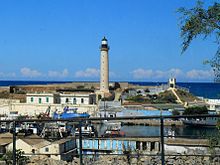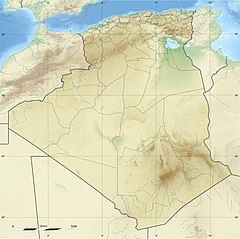Caesarea in Mauretania
|
Cherchell شرشال |
|
|---|---|

Cherchell's fountain place
|
|
 Location of Cherchell in the Tipaza Province |
|
| Location of Cherchell in the Tipaza Province | |
| Coordinates: 36°36′36″N 2°11′48″E / 36.61000°N 2.19667°ECoordinates: 36°36′36″N 2°11′48″E / 36.61000°N 2.19667°E | |
| Country | Algeria |
| Province | Tipaza |
| District | Cherchell |

Fort Joinville Lighthouse
|
|
|
Algeria
|
|
| Location | Fort Joinville Cherchell Algeria |
|---|---|
| Coordinates | 36°36′41.78″N 2°11′17.15″E / 36.6116056°N 2.1880972°E |
| Year first constructed | 1881 |
| Foundation | stone base |
| Construction | stone tower |
| Tower shape | cylindrical tower with balcony and lantern |
| Markings / pattern | unpainted tower, black lantern |
| Height | 28.60 metres (93.8 ft) |
| Focal height | 40.10 metres (131.6 ft) |
| Light source | main power |
| Intensity | 1,000 W |
| Range | 25 nautical miles (46 km; 29 mi) |
| Characteristic | Fl (2+1) W 15s. |
| Admiralty number | E6636 |
| NGA number | 22468 |
| ARLHS number | ALG-019 |
| Managing agent | Office Nationale de Signalisation Maritime |
Cherchell (older Cherchel, Arabic: شرشال) is a seaport town in the Province of Tipaza, Algeria, 55 miles west of Algiers. It is the district seat of Cherchell District. In 1998 it had a population of 24,400.
Phoenicians from Carthage founded a town at Cherchell around 400 BC, in an area on the northern Maghreb littoral 100 km west of Algiers. Established as a trading station, the city was originally known as Iol or Jol.
Cherchell became a part of the kingdom of Numidia under Jugurtha, who died in 104 BC. It served as a key city for the polity's Berber monarchy and generals. The Berber Kings Bocchus I and Bocchus II lived there, as occasionally did other Kings of Numidia. Iol was situated in an area called Mauretania, which was then a part of the Numidian kingdom.
During the 1st century BC, due to the city's strategic location, new defences were built.
The last Numidian king was Juba II; his wife was the Greek Ptolemaic princess Cleopatra Selene II, daughter of Marcus Antonius and Cleopatra of Egypt. In 29 BC, Roman emperor Augustus reorganized the area, appointing Juba king of the client kingdom Mauretania, which included western Numidia. The capital was established at Iol, renamed Caesarea or Caesarea Mauretaniae, in honor of the emperor.
...
Wikipedia


